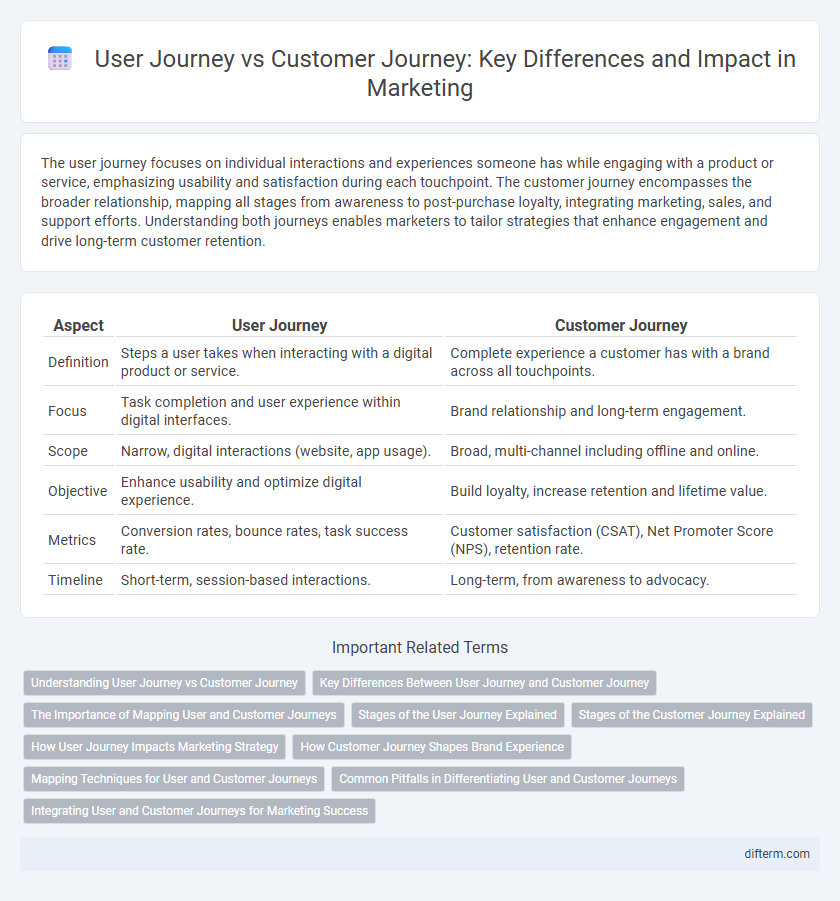The user journey focuses on individual interactions and experiences someone has while engaging with a product or service, emphasizing usability and satisfaction during each touchpoint. The customer journey encompasses the broader relationship, mapping all stages from awareness to post-purchase loyalty, integrating marketing, sales, and support efforts. Understanding both journeys enables marketers to tailor strategies that enhance engagement and drive long-term customer retention.
Table of Comparison
| Aspect | User Journey | Customer Journey |
|---|---|---|
| Definition | Steps a user takes when interacting with a digital product or service. | Complete experience a customer has with a brand across all touchpoints. |
| Focus | Task completion and user experience within digital interfaces. | Brand relationship and long-term engagement. |
| Scope | Narrow, digital interactions (website, app usage). | Broad, multi-channel including offline and online. |
| Objective | Enhance usability and optimize digital experience. | Build loyalty, increase retention and lifetime value. |
| Metrics | Conversion rates, bounce rates, task success rate. | Customer satisfaction (CSAT), Net Promoter Score (NPS), retention rate. |
| Timeline | Short-term, session-based interactions. | Long-term, from awareness to advocacy. |
Understanding User Journey vs Customer Journey
Understanding the user journey focuses on individual interactions and experiences across digital touchpoints, emphasizing usability and engagement metrics. The customer journey encompasses broader stages from awareness to post-purchase loyalty, integrating multi-channel marketing strategies and behavioral data. Analyzing both journeys enables marketers to optimize personalized experiences and improve conversion rates effectively.
Key Differences Between User Journey and Customer Journey
The user journey focuses on an individual's interactions with a product or service across various touchpoints, emphasizing usability and experience during specific tasks. The customer journey encompasses the broader relationship lifecycle, including pre-purchase awareness, decision-making, post-purchase support, and loyalty stages. Key differences lie in the scope and perspective: user journey centers on product engagement, while customer journey addresses the entire brand experience and emotional connection.
The Importance of Mapping User and Customer Journeys
Mapping user and customer journeys is crucial for understanding touchpoints and improving engagement across channels. Detailed journey maps reveal pain points and opportunities, enabling personalized marketing strategies that enhance conversion rates and customer retention. Effective journey mapping integrates behavioral data and feedback to optimize the overall brand experience.
Stages of the User Journey Explained
The user journey encompasses the complete stages a user experiences from awareness to engagement with a product or service, including discovery, consideration, conversion, and retention. Each stage involves distinct touchpoints that influence user behavior and decision-making, such as initial research, evaluating alternatives, purchase actions, and post-purchase interaction. Understanding these stages helps marketers optimize user experience and tailor communication strategies to increase satisfaction and loyalty throughout the customer lifecycle.
Stages of the Customer Journey Explained
The stages of the customer journey include awareness, consideration, decision, retention, and advocacy, mapping the entire process from initial exposure to brand loyalty. Each stage reflects a customer's evolving needs and interactions, requiring targeted marketing strategies to nurture progression and enhance satisfaction. Understanding these stages enables marketers to create personalized experiences that drive conversions and foster long-term relationships.
How User Journey Impacts Marketing Strategy
The user journey maps individual interactions with a brand across digital touchpoints, providing granular insights that refine targeting and content personalization. Understanding behavior patterns within the user journey enables marketers to optimize conversion funnels, reduce drop-offs, and enhance user experience, driving higher engagement rates. Incorporating user journey analytics into marketing strategy supports data-driven decisions, ensuring campaigns are tailored to meet specific needs at each stage of interaction.
How Customer Journey Shapes Brand Experience
Customer journey maps every interaction from awareness to purchase, directly influencing brand perception and loyalty. Understanding touchpoints allows marketers to tailor personalized experiences, enhancing emotional connections and satisfaction. Optimizing each stage fosters consistent brand messaging, driving higher engagement and long-term customer retention.
Mapping Techniques for User and Customer Journeys
Mapping techniques for user and customer journeys involve visualizing touchpoints, actions, emotions, and pain points that users or customers experience throughout their interaction with a brand. Tools like journey maps, service blueprints, and empathy maps help marketers identify key moments for engagement and optimization, ensuring a seamless experience that drives conversion and loyalty. Employing data-driven analytics and qualitative insights enhances the accuracy of these maps, facilitating targeted improvements in marketing strategies and user experience design.
Common Pitfalls in Differentiating User and Customer Journeys
Common pitfalls in differentiating user and customer journeys often stem from confusing interaction points, where users engage with a product but do not make purchasing decisions, unlike customers who complete transactions. Marketers should avoid assuming all users convert into customers, as this misconception can lead to misguided strategies that fail to address distinct behavioral patterns and motivational drivers. Recognizing these differences enables tailored experiences that optimize engagement, conversion rates, and long-term loyalty.
Integrating User and Customer Journeys for Marketing Success
Integrating user and customer journeys enhances marketing success by creating a seamless experience from initial interaction to post-purchase engagement, aligning touchpoints across channels and devices. Mapping both journeys reveals key behaviors and pain points, enabling personalized messaging and targeted campaigns that increase conversion rates and customer retention. Leveraging data analytics and CRM systems ensures consistent communication and a unified brand experience throughout the buyer lifecycle.
User journey vs customer journey Infographic

 difterm.com
difterm.com